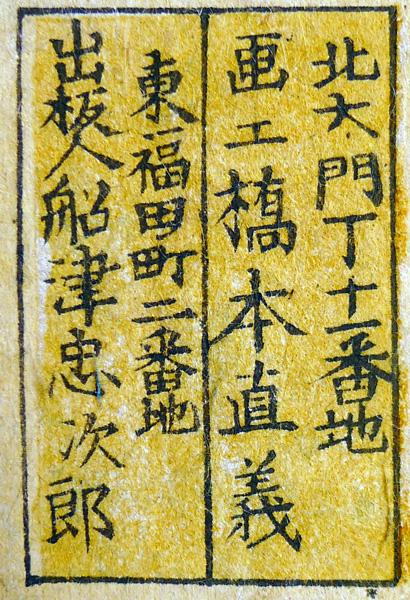About This Print
Saigō Takamori, the leader of the 1877 Satsuma Rebellion (and identified in the red cartouche on his immediate left as "Saigō Takamori the head rebel" 賊魁西郷隆盛), is flanked by his lieutenants Kirino Toshiaki 桐野利秋, to his right, and Shinohara Kunimoto 篠原国幹, to his left. Saigō, who had been dead several weeks when this print was published in October 1877, is standing on a hybrid tiger/wolf/badger demon1, representing the swift-killing disease cholera. Saigō is also pictured with a third arm, the meaning of which remains unclear to me. The imagery uses Saigō's status as an almost demigod after his death, to publicize a warning about a cholera epidemic that broke out the previous month. However, this is not one of the prints that sought to deify the rebel leader after his death, rather it uses double meanings to suggest that Saigo, and the chaos that resulted from his Rebellion, was responsible for the outbreak.Helping me to decipher the print's title, which appears in the large red cartouche at the top right of the print, were the ever-helpful participants on the Ukiyo-e Q&A message board, Sato-san and Guy-san. The print's title reads 西郷虎狼狸予暴魔茂痢奔損 and can be read in several ways. Taken literally, it denounces Saigō, and figuratively it reads, in a tongue-and-cheek manner, that the dead Saigō can magically ward off cholera.
Sato-san commented that "It's interesting that some kanji characters are used just as phonetic symbols in this title. They don't make sense, but are catchy enough to draw readers' attention to cholera epidemic."
While the background text notes that the epidemic started in Kagoshima (the area of Saigo's insurrection) and spread to a wider area in Kyushu, the below 1880 account of the epidemic by a medical authority traces the epidemic's origin to China and its entry into Japan through the port of Nagasaki.
For additional information on cholera and its depictions in Japanese prints see the website of the University of California, San Francisco "UCSF Japanese Woodblock Print Collection" http://asian.library.ucsf.edu/contagious-disease?page=0,2
The Print's Text
1 The idiom 'korori' (虎狼狸) or 'tiger-wolf-badger disease' pairs the ideograph for "tiger" (ko 虎) with the character for "wolf" (ro 狼) and "racoon dog" (tanuki or ri 狸)to sound out a rendering of the word 'cholera' into Japanese and to signify the tricky, unpredictable and fierce nature of the disease.
西郷虎狼狸予暴魔茂痢奔損 揚州周延 1877年 “西郷虎狼狸予暴魔茂痢奔損(さいごうころりよぼうまもりほんぞん) かなよみ新文 投書 會田皆眞子戯述補誌 コレラ這般(このたび)世に騒々舗(さハがしき)傳戦病(でんせんびやう)の次第ハ其始め鹿児島縣下私学校より萌芽(きざし)を顕(あらハ)し一時弾薬の工を奪ひ俄に毒気地方に觸れ新製暴毒の大言を吐瀉(はきくだ)し。死者狂ひの苦ミを諸人に及ぼし其病毒肥豊日隅に傳染(うつり)感ずる者同一に死を極め更に生命を顧ミず 此暴者病の豫防にハ諸国より徴剤を募(つの)り旅團丸を新選し亦(また)抜刀巡散を用ても功あり 一頃ハ益々烈しく既に九州一円に蔓延し落命の者少なからず 故に醫官ハ残らず詰切り病院縣廳の混薩(こんざつ)ハ鼎の沸が如く巡査ハ別働に警備をなし政府の御手配(おてくばり)専ら人民保護を尽される御仁恤ハ実に難有(ありがた)きこと也 抑(そも/\)此暴者病戦地ハ別して豫法(ふせぎかた)に注意して宜く襲ハれざるやう用心すべし 併(しかし)疾く降る症ハ生命に別条なけれど不決(ふけつ)なる者ハ進撃して焼棄るに不如(しかず)。最も怖るべき症と雖も漸々官軍勝利丸の功驗(きゝめ)に依て其病根を断に至り速に消滅鎮静凱旋すと其筋へ傳法ありしかバ万民漸(やゝ)安躰攸悦して後来この悪病の患ひなく天下泰平無事平穏を祈祝スト云々 明治十年十月廿三日御届 北大門丁十一番地 画工橋本直義 東福田町二番地 出版人船津忠次郎 定價一?銭五厘”
“桐野利秋 賊魁西郷隆盛 篠原國幹”
[Source: Osaka: The Merchants' Capital of Early Modern Japan, James L. McClain (Editor), Osamu Wakita (Editor, Preface), 1999, p. 233]
The 1877 Cholera Epidemic
Source: Cholera Epidemics in Japan. With a monograph on the influence of the habits and customs of races on the prevalence of cholera, Duane B. Simmons, M.D., Shanghai: Printed at the Statistical Department of the Inspectorate General of Customs, 1880, p. 4, 7-8.Cholera had been absent from Japan for 15 years, before the September 1877 outbreak which resulted in over 6,500 deaths. In light of the severity of previous epidemics "Temporary cholera hospitals were built at the open ports with all possible despatch, and general information respecting prophylactics and the proper modes of treatment was diffused among the people by means of the newspapers and printed pamphlets."
In his report on the origins of the epidemic, Dr. Simmons, Chairman of the Yokohama Foreign Board of Health, noted:
| Under circumstances the most favourable for observation it is often very difficult to fix upon the exact vehicle by means of which cholera gains an entrance into a country. So we find it in regard to the epidemic of 1877. Even the government, after several months devoted to the investigation of the subject, succeeded in arriving at no more than an approximation of the facts. Grave difficulties, in addition to the absence of quarantine regulations and universal inspection of ships coming from infected ports, were occasioned by the Satsuma rebellion, then at its height. In the history of cholera everywhere, war has been one of the most potent instruments for the transportation of the disease. The necessities of campaigning defy all ordinary rules, sanitary or other. But though this insurrection was no doubt responsible for the spread of cholera in and about the neighbourhood of the scene of strife, it can in no way be accused of originating the epidemic, which, as the facts enumerated in the Chinese Customs reports already quoted tend to establish, must have come first from China to Nagasaki, whence it afterwards spread to two other open ports, Hiogo and Yokohama. |
Print Details
| IHL Catalog | #777 |
| Title or Description | Mr. Saigō's Amazing Charm to Ward Off Cholera [Reliable Saigō Will Protect You Against Cholera Infection] Saigō korori yobō mamori honzon 西郷虎狼狸予暴魔茂痢奔損 |
| Series | |
| Artist | Yōshū Chikanobu (1838-1912) |
| Signature | unsigned, but the publisher's yellow cartouche (shown below) identifies the artist as Yōshū Chikanobu. The right side of the cartouche reads as follows: 画工 [gakou or artist] followed by 橋本直義 [Hashimoto Naoyoshi, Chikanobu's birth name] followed by the address for his place of residence. |
| Seal | no seal |
| Publication Date |  |
| Publisher |  left half of cartouche: 出板人[shuppanjin (publisher)] 船津忠次郎 [Funazu Chūjirō] followed by the publisher's address of Higashifukudachō 2-banchi [Marks: seal 26-116; pub. ref. 077] right half of cartouche: see Signature above. |
| Impression | excellent |
| Colors | excellent |
| Condition | fair – possibly one sheet from a triptych; soiling throughout; paper wrinkling; not backed |
| Genre | ukiyo-e; fūshi-ga |
| Miscellaneous |  |
| Format | vertical oban |
| H x W Paper | 13 7/8 x 9 1/2 in. (35.2 x 24.1 cm) |
| Literature | |
| Collections This Print |
4/19/2020


